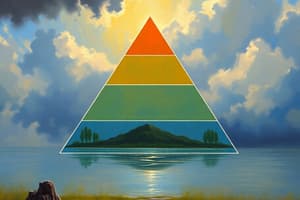Podcast
Questions and Answers
What percentage of energy is transferred from one trophic level to the next?
What percentage of energy is transferred from one trophic level to the next?
- 90%
- 25%
- 50%
- 10% (correct)
Producers, like grass, are at the highest trophic level in an ecological pyramid.
Producers, like grass, are at the highest trophic level in an ecological pyramid.
False (B)
Name one example of a primary consumer in a food chain.
Name one example of a primary consumer in a food chain.
grasshopper
In a food chain, the ______ is the organism that produces energy through photosynthesis.
In a food chain, the ______ is the organism that produces energy through photosynthesis.
Match the following organisms to their respective trophic levels:
Match the following organisms to their respective trophic levels:
Flashcards
Food Chain
Food Chain
The transfer of energy between organisms in an ecosystem, where each organism consumes another, creating a chain of energy flow.
Ecological Pyramid
Ecological Pyramid
A diagram that shows the amount of energy at each trophic level in an ecosystem, usually shaped like a pyramid.
Trophic Level
Trophic Level
The position an organism occupies in a food chain based on its feeding source.
Producers (autotrophs)
Producers (autotrophs)
Signup and view all the flashcards
Primary Consumers (herbivores)
Primary Consumers (herbivores)
Signup and view all the flashcards
Study Notes
Food Chains and Energy Pyramids
- Feeding relationships follow multiple food chains.
- Arrows in food chains should point in the correct direction.
- Ecological energy pyramids show energy transfer between trophic levels.
- Only about 10% of the energy from one trophic level transfers to the next.
- The remaining 90% of energy is lost as heat.
- Each trophic level can support fewer organisms compared to the level below.
- The trophic level depends on the number of steps from the producer.
- The first trophic level consists of autotrophs (e.g., grass).
- The second trophic level consists of primary consumers (e.g., grasshoppers).
- Higher trophic levels include secondary and tertiary consumers (e.g., snakes, eagles).
Studying That Suits You
Use AI to generate personalized quizzes and flashcards to suit your learning preferences.




